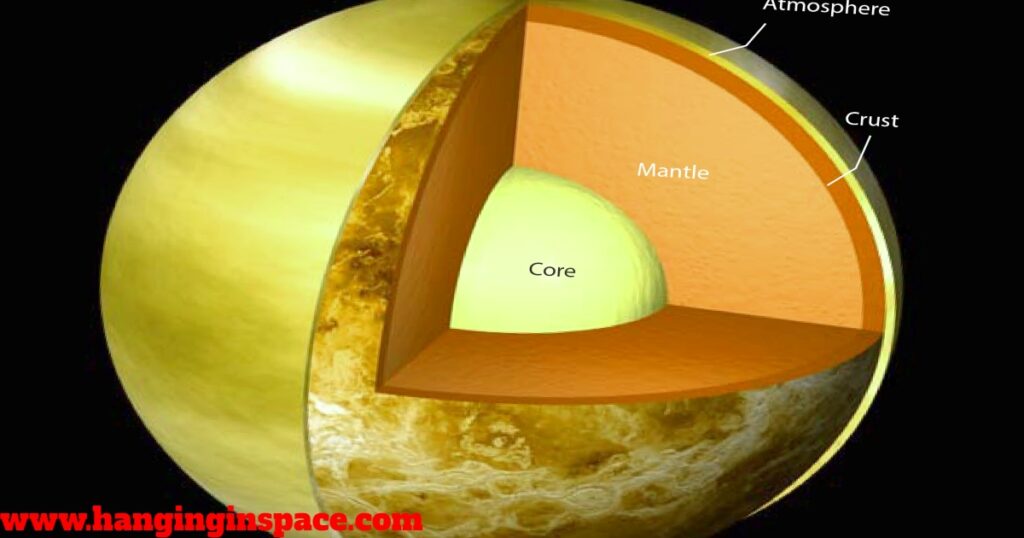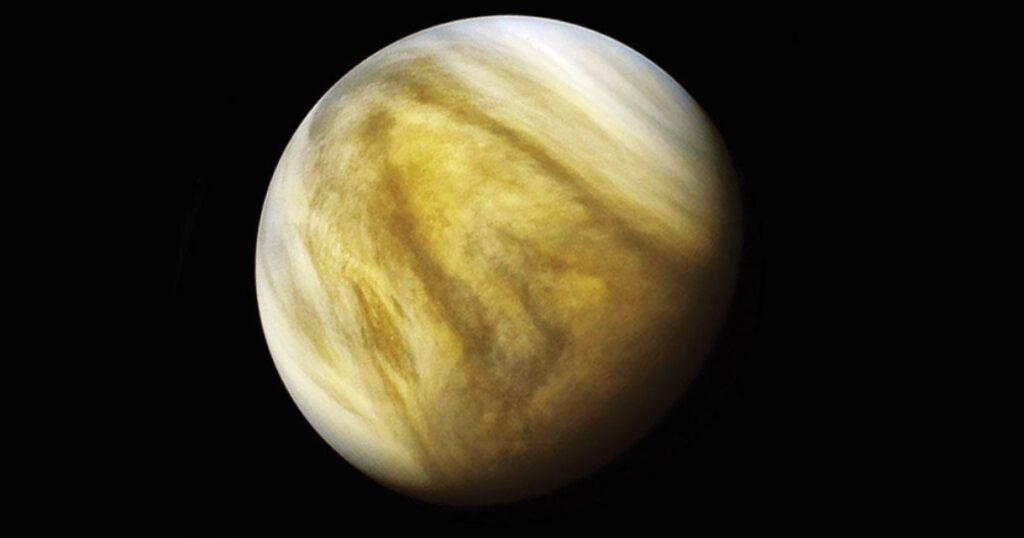Venus is the second planet from the Sun in our solar system, known for its thick atmosphere primarily composed of carbon dioxide, and its extreme surface temperatures, making it the hottest planet in our solar system.
It has a rocky surface marked by volcanic features and dense clouds of sulfuric acid. Venus is also called Earth‘s “sister planet” due to its similar size and composition.

What is the Size of Venus?
Venus’ radius is 6,051.8 kilometers (3,760.4 miles). Venus’ diameter is 12,103.6 kilometers (7,520.8 miles). Venus’ circumference is 38,025.1 kilometers (23,627.9 miles).
What is the Mass and Volume of Venus?
The mass of Venus is approximately 4.8675 x 10^24 kilograms (kg), and its volume is approximately 9.28 x 10^11 cubic kilometers (km³).
What is the Temperature of Venus?
Temperatures on Venus routinely sizzle above 460 degrees Celsius (863 degrees Fahrenheit), hot enough to melt lead. Combined with crushing atmospheric pressure, Venus’s atmosphere presents a hostile environment for exploration and serves as a cautionary example of the impact of greenhouse gases on planetary climates.
What is Venus’ Average Distance from the Sun & Earth?
Venus orbits the Sun at an average distance of approximately 108.2 million kilometers (about 67.2 million miles). In terms of its distance from Earth, Venus can vary significantly due to the elliptical nature of its orbit. On average, Venus is about 41 million kilometers (25.5 million miles) away from Earth.
How long does it take Venus to Orbit the Sun?
Venus travels around the Sun in just 224.7 Earth days. This is shorter than a year on Earth (365.25 days).
How long does it take Venus to Spin on its Axis?
Venus takes a very long time to spin on its axis compared to most planets, including Earth. It takes 243 Earth days for Venus to complete one full rotation.
Gravitational Field Strength:
The surface gravity of Venus is approximately 8.87 m/s² (meters per second squared). This is about 90% of Earth’s surface gravity (which is 9.81 m/s²).
Escape Velocity:
The escape velocity required to leave the gravitational pull of Venus is approximately 10.36 kilometers per second (km/s).
Venus does not have any moons. It is one of the two planets in our solar system, along with Mercury, that does not have any natural satellites orbiting around it.
What is the Composition of Venus?
Scientific evidence suggests that Venus shares a similar bulk composition to Earth. Both planets are believed to have formed from the swirling disk of gas and dust that coalesced into our solar system billions of years ago.
This means they likely share a common foundation of elements like iron, silicon, oxygen, and magnesium. However, the proportions of these elements and the way they are combined may differ between the two planets.
One of the most striking features of Venus’ atmosphere is its overwhelming dominance of carbon dioxide (CO2). This gas makes up a staggering 96% of the atmosphere, far exceeding the levels found on Earth.
The remaining 4% is a cocktail of other gases, including nitrogen, sulfur dioxide, and traces of water vapor. This thick CO2 blanket traps immense heat from the Sun, creating a runaway greenhouse effect that makes Venus the hottest planet in our solar system, even surpassing Mercury’s scorching temperatures despite being farther from the Sun.
What is the Interior Structure of Venus?
Venus’ interior structure consists of a core, mantle, and crust.
The Core:
The core of Venus is most likely composed of iron, similar to Earth’s core. However, the immense pressure and heat on Venus may cause the iron to exist in a different state compared to the solid iron core found on our planet. Some theories suggest the presence of a molten iron outer core surrounding a solid inner core.
The Mantle:
Above the core lies the mantle, the largest layer of Venus. Scientists believe it’s primarily composed of silicate rocks, similar to Earth’s mantle. However, the extreme heat and pressure on Venus may alter the composition and behavior of these rocks compared to their Earthly counterparts.
The intense heat may cause partial melting in the mantle, leading to convection currents that could drive volcanic activity on the Venusian surface.
The Crust:
The outermost layer of Venus is its crust, which is thought to be composed of basaltic rocks, volcanic rock similar to what is found on Earth’s ocean floor. Unlike Earth, which has a dynamic, constantly moving and reshaping crust due to plate tectonics, the crust of Venus appears to be relatively rigid and stagnant.

What does the Atmosphere of Venus consist of?
Venus, our neighboring planet, boasts an atmosphere dominated by carbon dioxide with traces of nitrogen and sulfuric acid clouds. This thick atmosphere creates a potent greenhouse effect, trapping heat and resulting in extreme surface temperatures.
Venus’s atmosphere has a three-layer structure:
Lower Atmosphere (Troposphere):
The thickest layer, where most weather phenomena occur, like powerful winds and the circulation of sulfuric acid clouds.
Middle Atmosphere (Mesosphere):
The middle layer, where temperatures start to decrease with increasing altitude.
Thermosphere:
The uppermost layer, where temperatures rise sharply due to the absorption of solar radiation. Here, the atmosphere gradually thins out into space.
What is Venus’ Magnetosphere?
Venus has a very weak magnetic field, and its magnetosphere is much smaller than Earth’s. It provides little protection from the solar wind, contributing to Venus’s lack of an atmosphere and extreme surface temperatures.

What are the Mysteries about Venus?
Despite the progress made in understanding Venus’ composition, many questions remain unanswered. Here are some of Venus’ mysteries:
Volcanic Activity:
Evidence suggests ongoing volcanic activity on Venus, but the full extent and nature of this activity remain unclear.
Water Vapor:
Traces of water vapor have been detected in the Venusian atmosphere.
The Lack of a Magnetic Field:
Unlike Earth, Venus lacks a global magnetic field.
Venus’ Formation:
Venus, like other planets in the solar system, formed approximately 4.5 billion years ago through a process known as accretion. During the early stages of the solar system’s formation, gas and dust particles in the protoplanetary disk began to clump together due to gravitational attraction, forming larger and larger bodies called planetesimals.
These planetesimals eventually collided and merged to form protoplanets, which further accreted material until they became fully-fledged planets.
The formation of Venus likely followed a similar process, with dust and gas in the early solar system coalescing to form a protoplanetary disk around the young Sun. Within this disk, particles collided and stuck together, gradually building up the rocky core of Venus.
Over time, this core grew larger as it attracted more material, eventually reaching a critical mass and undergoing differentiation to form distinct layers, including a metallic core and a silicate mantle.
As Venus continued to accrete material, it began to heat up due to the energy released by impacts and the decay of radioactive elements. This heat, combined with the pressure from the growing mass of the planet, led to the development of a thick atmosphere composed primarily of carbon dioxide and other greenhouse gases.
Over millions of years, this atmosphere trapped heat from the Sun, creating the extreme temperatures and high pressures that characterize Venus today.
While the exact details of Venus’ formation are still being studied, it is clear that the planet underwent a complex process of accretion and differentiation, ultimately resulting in its current composition and structure. Studying Venus’ formation can provide valuable insights into the early history of the solar system and the processes that shaped the planets we see today.
When and Who Discovered Venus?
Venus has been known since ancient times, and it is one of the five planets visible to the naked eye. Its discovery cannot be attributed to a single individual, as it was observed and documented by numerous ancient civilizations, including the Babylonians, Greeks, and Egyptians.
However, the detailed study of Venus and its movements began in earnest during the early modern period, with advancements in astronomy and the development of telescopes.
Astronomers such as Galileo Galilei and Johannes Kepler made significant contributions to our understanding of Venus’ orbit and phases. Today, Venus remains a subject of fascination and study, both for its unique characteristics and its potential insights into the study of planetary formation and evolution.
Venus’ Exploration:
Several landers from the former Soviet Union have arrived on Venus. They were only able to transmit information for a brief period because the incredibly high temperature and pressure on Venus’ surface melted and crushed the landing craft.
As technology advances, scientists are developing new missions to explore Venus in greater detail. These missions aim to unlock the secrets of its atmosphere, probe its surface features, and investigate the possibility of past or present life. By unraveling the mysteries of Venus, we gain a deeper understanding of our own planet’s formation and evolution.
Venus as compared to Earth:
Venus Vs. Earth
| Feature | Venus | Earth |
|---|---|---|
| Distance from the Sun (average) | 108 million km | 149.6 million km |
| Size (diameter) | 6,052 km | 6,371 km |
| Volume | 0.866 Earth | 1 Earth |
| Mass | 4.867 x 10^24 kg | 5.972 x 10^24 kg |
| Density | 5.24 g/cm³ | 5.51 g/cm³ |
| Atmosphere | 96% Carbon Dioxide, 3.5% Nitrogen, Traces of Others | 78% Nitrogen, 21% Oxygen, 1% Argon, Traces of Others |
| Surface Temperature | 462°C (average) | 15°C (average) |
| Surface Pressure | 90 times Earth’s atmospheric pressure | 1 bar (sea level) |
| Rotation | 243 days (retrograde) | 1 day |
| Presence of Liquid Water | No | Yes (oceans, lakes, rivers) |
| Magnetic Field | Weak, Induced by Solar Wind | Strong, Generated by Molten Core |
| Moons | None | 1 (Moon) |
Conclusion:
In summary, Venus’s composition and interior structure share many similarities with Earth, but its thick, toxic atmosphere and extreme surface conditions make it a hostile environment for life as we know it. Despite these challenges, scientists continue to study Venus to better understand the processes that shape terrestrial planets and to unravel the mysteries of our neighboring world.
